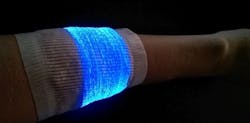| Where polymer optical fibers are woven into the fabric and connected to LEDs, the fabric shines at the therapeutic wavelength of 470 nm. The satin fabric is breathable and comfortable on the skin. (Image: Empa) |
When being treated for jaundice in incubators, newborns must lie naked and with their eyes covered for protection. Irradiation with blue light in an incubator is necessary because toxic decomposition products of the blood pigment hemoglobin are deposited in the skin in newborns with jaundice. Researchers at the Empa division Biomimetic Membranes and Textiles (Dübendorf, Switzerland) have now improved this not-so-child-friendly procedure by developing illuminated pajamas for babies.1
To do this, the material researchers created textiles with polymer optical fibers woven into them. Battery-operated LEDs serve as a light source for the light-conducting threads. Together with conventional thread, the optical fibers are woven into a satin material that distributes the light supply evenly throughout the fabric, and is comfortable to the newborn.
With a diameter of around 160 µm, the dimensions of the optical fibers match that of regular threads.
Photonic textiles woven in this manner can be made into a romper or a sleeping bag so the little patient is clothed, and can be held and fed. Because the pajamas can be produced for commercial use so they only radiate light inward onto the baby's skin, it is no longer necessary for the newborn to wear an annoying protective mask. Unlike in the incubator, where the treatment light shines on the infant's face, the 740 nm of the light pajamas doesn't reach the baby's sensitive eyes.
Light intensities of 30 µW/cm2 in the blue are required for jaundice treatment; the prototype of the pajamas currently produces a lower intensity. "For commercial production, the light intensity of the pajamas must therefore be increased somewhat," says researcher Maike Quandt. However, this shouldn't be too big of a problem since it just requires the use of stronger LEDs.
Quandt notes that the illuminated fabrics are also suitable for everyday wear. "The photonic textiles are washable and tolerated well by the skin," she says.
Source: https://www.empa.ch/web/s604/photonic-textiles-for-newborns
REFERENCE:
1. Brit M. Quandt et al., Biomedical Optics Express (2017); https://doi.org/10.1364/BOE.8.004316
